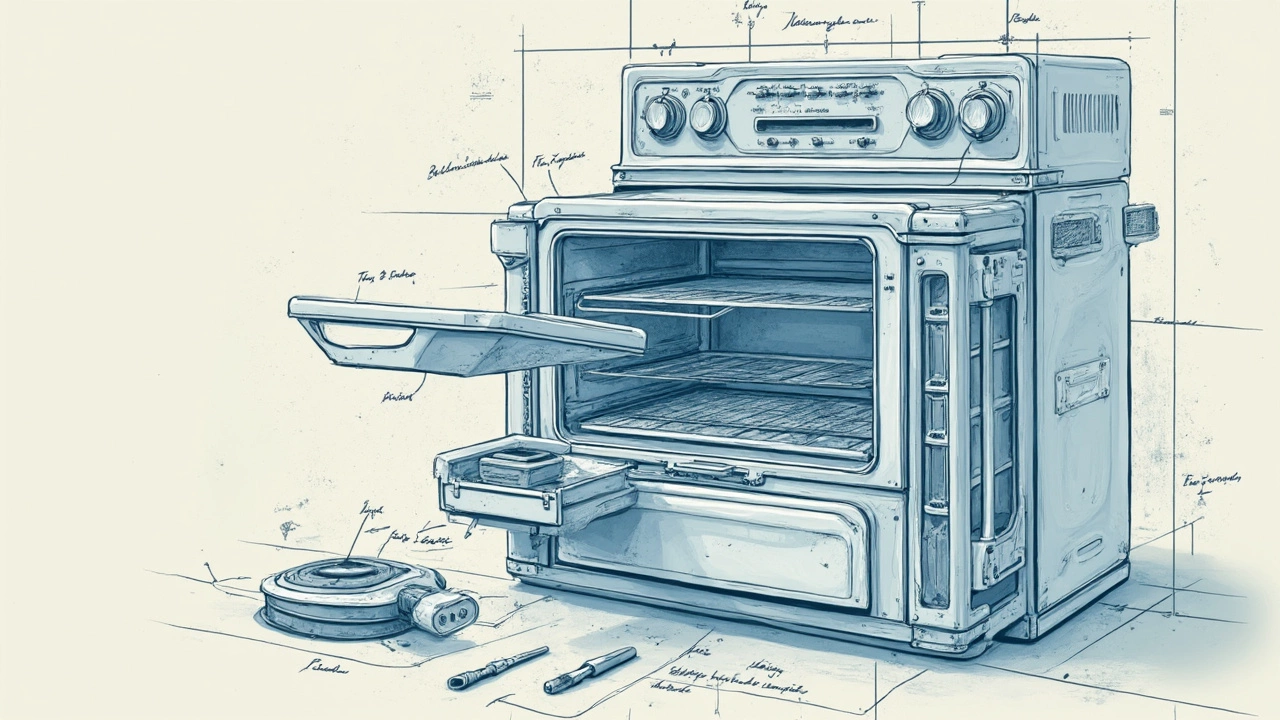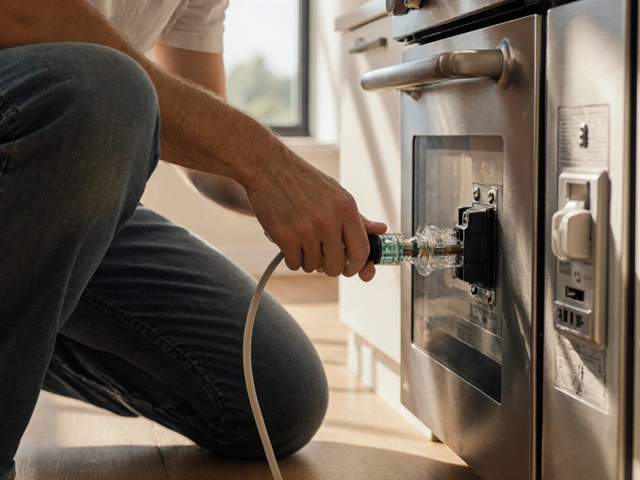Ever had the sudden realization that your electric oven just decided to take a day off? It's not the end of the world, but yes, it can be frustrating—especially if you're gearing up to bake your famous banana bread. The good news is, more often than not, you can actually fix it yourself with a little bit of know-how and some patience.
Let's get the ball rolling by understanding some of the common issues people face with electric ovens. Is it not heating up? Maybe the temperature's not quite right? Or, is it just not doing anything at all? Each symptom can hint at a different problem, and knowing these can help demystify the root cause of the issue.
Once you've got a clue about what's going on, basic troubleshooting becomes your next step. Sometimes, the solution is as simple as double-checking the power connection or inspecting the thermostat. It might sound a bit obvious, but you'd be surprised at how often a little tightening here and there solves the problem.
- Identifying Common Problems
- Basic Troubleshooting Steps
- Tools You Might Need
- When to Call a Professional
- Cost-Effective Repair Tips
- Preventive Maintenance for Longevity
Identifying Common Problems
Alright, let's tackle those pesky issues that most people face with their electric oven at some point. Knowing the usual suspects can really help narrow down what’s going wrong when your beloved kitchen buddy starts acting up.
Oven Not Heating
If your electric oven isn't heating, the number one thing to check is the heating element. These elements are usually visible inside the oven, and if they look cracked or damaged, you've likely found the culprit. Another common fix here involves looking at the oven's power source or checking if it's been tripped at the electrical panel. A simple reset might do the trick.
Temperature Inconsistencies
Nothing's worse than a cake that's burnt on the outside but raw on the inside. If you're facing wild temperature swings, the thermostat might not be doing its job properly. It’s like the brain of your oven—if it starts to malfunction, you'll notice the difference immediately.
Door Not Closing
A door that doesn’t close properly is often a mechanical issue related to the door’s hinges or latch. These can sometimes wear out or simply get out of alignment. Fixing this can often be as straightforward as a quick adjustment.
Strange Noises
Weird noises coming from the oven can give anyone the heebie-jeebies. Often, these are caused by the fan motor, which may be on its last legs. It's worth listening closely to identify the type of noise and its source. Replacing the fan is usually the way to go if it’s making grinding or squealing sounds.
Oven Not Turning On
If your oven's giving you the cold shoulder and refusing to turn on at all, the issue could be as simple as a blown fuse or tripped circuit breaker. Make sure you check out the power source, and for electric models, confirm that the outlet isn't the problem.
Understanding these electric oven repair basics can really empower you, especially before reaching for the phone to call in the pros. Plus, some of these issues may have simple fixes that can save both time and money!
Basic Troubleshooting Steps
Before diving into any technical repair, let's take a closer look at some basic troubleshooting steps you can easily try yourself. It's all about narrowing down the cause so you can fix your electric oven without stress.
Step 1: Check the Power Supply
First things first. Make sure your oven is actually getting power. Check the circuit breaker to see if it's been tripped. If you reset it and it trips again, the problem might be electrical, and you'll need a pro to look at it.
Step 2: Inspect the Oven Door
If your oven's not heating up, double-check that the door is firmly closed. A loose door seal can let heat escape and stop the oven from reaching the right temperature. Try pushing it shut or replacing the seal if it's looking worn out.
Step 3: Examine the Heating Elements
Heating elements can sometimes wear out. Turn on the oven and take a peek inside. If the elements aren’t glowing, you might need to replace them. It’s a straightforward swap, just make sure to follow the instructions carefully for your oven model.
Step 4: Check the Thermostat
If everything else seems okay, the thermostat might be the issue if it's not reading the temperature correctly. See if it’s properly calibrated or needs replacing.
More Checks
- Look for error codes on the control panel.
- Make sure the clock and timer are set correctly, as some ovens won't function if they're off.
- You could try unplugging the oven for a few minutes to reset it—like giving it a mini power nap.
| Issue | Potential Cause | Solution |
|---|---|---|
| No Heat | Element Failure | Replace Element |
| Inconsistent Temperature | Faulty Thermostat | Check/Replace Thermostat |
| Door Won’t Close | Worn Seal | Replace Seal |
And remember, safety comes first. If at any point you feel uncomfortable tackling these basic steps, don't hesitate to reach out to a professional. Knowing your limits is just as important as knowing how the oven works.
Tools You Might Need
So you're ready to play detective and figure out what's up with your electric oven? Well, before you start, let's talk about the tools you'll want on hand. No fancy gadgets required—just some basics that'll make your life a whole lot easier.
Essential Tools
First things first, grab a screwdriver set. You'll need both Phillips and flathead types to tackle different screws. These are your go-to for uncovering what's inside those panels.
- Multimeter: This bad boy tests voltage and continuity. With a multimeter, you can safely check if your oven’s getting power and pinpoint faulty parts.
- Nut driver: Some ovens have nuts instead of screws. A set of nut drivers will help you loosen and tighten these like a pro.
Helpful Additions
Got the essentials? Great. Here are a few more things that'll help you on your repair quest:
- Needle-nose pliers: Perfect for disconnecting wires or fishing out small components without causing any damage.
- Flashlight or headlamp: Some oven parts can be tucked away in shadowy spots. A good light source will make sure you see everything clearly.
Having these tools on hand will make the troubleshooting and electric oven repair process smoother. Even if you're not planning to become an appliance repair guru, they’re handy for other household fixes.
And hey, remember: safety first. Always unplug the oven before starting any repair work to avoid any risk of electric shock. Happy fixing!

When to Call a Professional
So, you've done your homework, checked the usual suspects, and still, your electric oven refuses to get its act together. At this point, it might be time to bring in the heavy artillery—a professional repair technician. Why, you ask? Well, there are some situations where their expertise and tools are just what the doctor ordered.
Electrical Issues
If you suspect electrical issues or have tripped a breaker every time you try to use the oven, it's definitely in the range of "call a pro" territory. Messing with electricity is risky business, and professionals have the know-how plus equipment to handle these hazards safely.
Complex Component Repairs
Ovens are packed with components like heating elements, wiring harnesses, and control boards. If you've done the basic checks but these components could be faulty, an experienced technician has the necessary skills to dig deeper. They can diagnose complex parts with precision and replace them if necessary.
Ensuring Safety Standards
Repairing appliances isn't just about getting them to work again but ensuring they operate safely long-term. Professionals are trained to look for potential safety hazards and can provide peace of mind that your oven meets all safety standards.
Time and Cost Efficiency
Although a DIY approach can save money, it often takes more time and could potentially worsen the issue, leading to greater expenses later. Professionals offer quicker turnarounds and usually come with warranties on their work.
| DIY vs. Professional Repair | Pros | Cons |
|---|---|---|
| DIY Repair | Cost-effective, Learning experience | Time-consuming, Risk of errors |
| Professional Repair | Expert knowledge, Warranty on work | Higher initial cost |
Overall, if you're faced with issues outside your comfort zone or expertise, calling in a specialist for your electric oven repair is the way to go. It's about ensuring the job is done right and keeping your kitchen—and home—safe.
Cost-Effective Repair Tips
Fixing your electric oven doesn't need to break the bank. Yeah, it might sound a bit daunting, but let's keep it simple. There are many tricks to get your oven up and running without calling in the pros—or emptying your wallet.
Check the Basics First
Before diving into more complicated stuff, start with the obvious. Make sure the oven is actually plugged in and that the circuit breaker hasn't tripped. These are quick fixes that won't cost you a dime.
Replace Worn Parts Yourself
Many issues are due to worn-out parts, like heating elements or thermostats. If you've identified the culprit, you can often replace it yourself. Here's how you’d typically do it:
- First, ensure everything is unplugged—safety first!
- Next, unscrew the back panel (careful not to lose the screws).
- Disconnect the damaged component. Make note of how wires connect; you’ll need to remember this.
- Swap in the new piece and reverse the process to secure everything back into place.
Using a trusted online retailer or visiting a local appliance store, you can get these replacement parts for a fraction of the cost of a technician visit.
Keep Your Eye on Energy Efficiency
Another way to save is by ensuring your oven runs efficiently. Overuse of energy can hint at a need for repair or upkeep. For instance, a good, clean seal around the oven door can save a lot. It ensures heat doesn’t escape, letting your food cook without the oven working overtime.
To check the door seal, look for cracks or hardened edges. Replacing or even repairing with some heat-resistant tape could significantly up your oven's performance.
Utilize Free Resources
We're lucky to have access to tons of free information online. Sites like YouTube are goldmines for DIY repair tutorials. Whether you need help replacing a part or troubleshooting an issue, chances are someone’s made a video about it.
Don't Forget Regular Maintenance
Sometimes, staying on top of routine checks can help prevent bigger repairs down the line. Cleaning the oven regularly, especially those hidden away corners, keeps everything in good shape. Plus, it’s cost-effective as it saves future hassle.
The key to oven troubleshooting and repair is a mix of common sense, online resources, and a dash of bravery. Dive in, stay safe, and you'll often find that most issues have budget-friendly solutions.
Preventive Maintenance for Longevity
Keeping your electric oven in perfect shape doesn't just happen; it takes a little bit of regular TLC. A well-maintained oven not only lasts longer but can also cook more efficiently. Here’s how you can make sure you’re giving your oven some love.
Regular Cleaning Routine
First things first, you’ve got to keep it clean. Sure, it's no one’s favorite weekend job, but tackling those spills and crumbs regularly will prevent them from burning and affecting performance. Just waiting until it looks too gross to handle only makes it worse.
- Wipe down the exterior and controls weekly with a damp cloth and mild detergent.
- Remove racks and clean them separately; soaking works wonders.
- Once a month, give the interior a good scrub with a mix of baking soda and water. Avoid using harsh chemicals that can damage the surfaces.
Check for Proper Functioning
Regular inspections can nip problems in the bud before they become costly repairs. Here’s what to keep an eye out for:
- Inspect the door seals every few months. A worn-out gasket can cause heat loss.
- Check if the burners are heating uniformly. Uneven heating means it’s time to look at those heating elements.
- Every year, check the calibration of the thermostat. An oven thermometer can help you keep track of the temperature.
Getting the Techie Stuff Right
If you’re a bit of a techie, diving into some of the electronic components every now and then can prevent surprises down the road.
- Turn off the power and remove the back panel to check for any loose connections.
- Ensure that all wiring looks intact. Frayed wires are a no-go and need replacing.
- Inspect electronic control boards for burnt-out or damaged components.
Maintaining your oven isn’t just about preventing headaches later; it also means your oven performs better daily. If you're ever unsure about certain checks, there's no shame in calling a professional. After all, peace of mind sometimes takes a little expert guidance.




